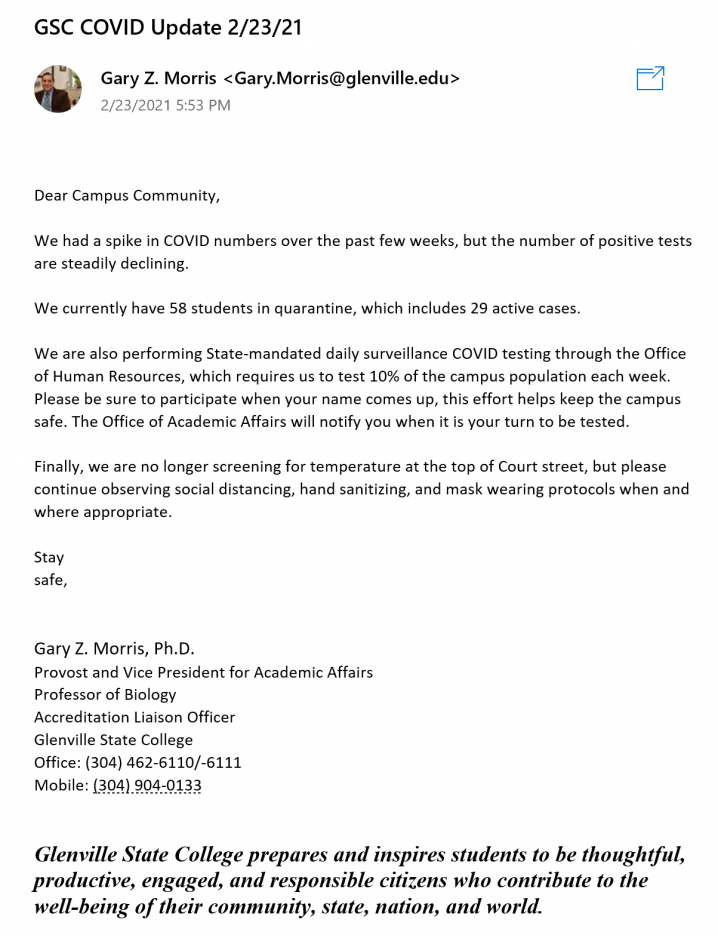
By Sadie Murphy
Students received an email on February 23 from Dr. Gary Morris informing us that “[Our college is] no longer screening for temperatures at the top of Court street.”5 While some are concerned about losing a screening method, the school may be sane to decrease temperature checks around campus.
“The core concept is something we are all familiar with — using a thermometer to see if someone has an elevated body temperature (EBT).”
The CDC (U.S. Centers for Disease Control and Prevention) recommends screening temperatures for a fever, one of the criteria for COVID. They “ consider a person to have a fever if their temperature registers 100.4 or higher -- meaning it would be almost two degrees above what's considered an average ‘normal’ temperature of 98.6 degrees.”1 It is important to know if you’re running a fever because“an EBT is an indication that your body’s immune system is fighting an infectious agent, such as a virus or bacteria.”2
However, using an increased temperature to assess whether someone is COVID free can prove problematic. “It’s a very crude estimate to say that a normal temperature is 98.6 Fahrenheit. It depends on the body area where you are checking the temperature. It depends on what device you’re taking the temperature with. And, in terms of interpreting it, it depends on the patient. Is this a young person? Middle aged? Is it an older person? There are a lot of variables involved.” Stanford University found that on average, we run at a lower baseline temperature than the previous century. “That means a patient who has a baseline temperature of 97.5 could actually have a 2-degree temperature and register at lower than [the CDCs outlined] 100.4.”1
Comparatively, “temperature checks are not a guarantee that [individuals] who don’t have an elevated temperature also don’t have Covid-19. The reverse is also true: Feverish travelers might not have Covid-19.”3 One reason this proves correct is because COVID individuals can be asymptomatic, which means they are positive for Corona but lack symptoms, such as a fever. Another reason is because a fever does not indicate a specific virus or bacteria (such as COVID). It only indicates that the bodies immune system is inflamed.
“There is no definitive study on the predictive value of temperature checks for Covid-19. But there are clues from when that strategy was used during the SARS epidemic of 2003.” In this case, devices proved less than ideal.4
On the other hand, Sharon Begley researched the growing body of science that suggested smell tests are the way of the future. Smell tests assess anosmia – the loss of sense of smell. “[Smell tests are] potentially a more sensitive screen for asymptomatic patients.” Andrew Badley collected data and found that “Covid-19 patients were 27 times more likely than others to have lost their sense of smell while patients were only 2.6 times more likely to have fever or chill.”4 This study indicates that patients are over 10 times more likely to have anosmia than to run a fever.
Would you be willing to take a “smell test’ to decrease the spread of COVID-19? Only the future will tell. Morris asks that we “please continue observing social distancing, hand sanitizing, and mask wearing protocols when and where appropriate.”5
- https://www.capecodhealth.org/medical-services/infectious-disease/coronavirus/is-temperature-a-good-marker-for-covid-19/
- https://austinstartups.com/pros-and-cons-of-fever-scanning-d108dcc28ef2
- https://www.statnews.com/2020/07/02/smell-tests-temperature-checks-covid19/
- https://www.statnews.com/2020/07/02/smell-tests-temperature-checks-covid19/
- Screenshot of email to students depicted below.

Share article on:

